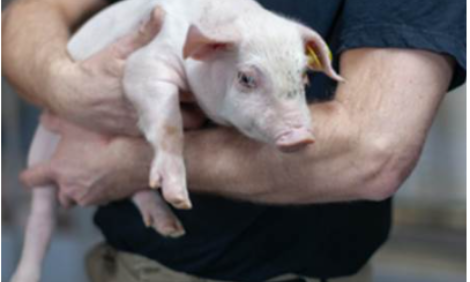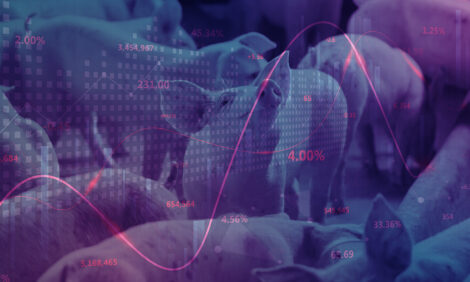



US Pork Outlook Report - October 2004
By U.S.D.A., Economic Research Service - This article is an extract from the October 2004: Livestock, Dairy and Poultry Outlook Report, highlighting Global Pork Industry data. The report indicates Hog prices are high, despite the increased production.
Hog Prices High, Despite Increased Production
Hog prices this year have been driven largely by demand factors: very strong domestic
demand for animal proteins, relatively high domestic beef prices, and strong export
demand, particularly from Mexico and Taiwan. The same set of demand factors, in
varying degrees, is expected to support hog prices in the $47 to $51 per hundredweight
(cwt) range in 2005, although larger pork supplies are expected.
Pork production in
2005 will come close to 21 billion pounds, driven by higher market hog inventories,
increased farrowing intentions, and a larger breeding herd--all as reported in the
September 1 Quarterly Hogs and Pigs report. Larger hog numbers plus lower feed costs
resulting from large U.S. corn and soybean crops will encourage pork production next
year.
Fourth-quarter prices of 51-52 percent hogs (live equivalent) are expected to range
between $49 and $51 per cwt, almost 36 percent higher than the same period last year.
Fourth-quarter production will approach 5.5 billion pounds--about the same as fourthquarter
2003--implying weekly slaughters of about 2.1 million head until the end of the
year.
Higher Production, Strong Hog Prices Expected in 2005
Several key supply and demand variables are signaling 2005 pork production of almost 21 billion pounds, with 51-52 percent live equivalent hog prices between $47 and $51 per cwt. Supply variables pointing to higher production include increased inventories of market hogs and breeding animals, as well as higher farrowing intentions reported in the September Quarterly Hogs and Pigs report, and lower feed costs from large U.S. corn and soybean crops. Continued strong demand for pork products by domestic and foreign consumers next year, combined with relatively high domestic beef prices are expected to support hog prices, despite higher supplies.
Quarterly Hogs and Pigs Report Shows Larger Inventories, Farrowing Intentions
|
Retail Pork Price
Percent change from previous month 
|
The herd of breeding animals also showed a year-over-year increase of 1 percent, suggesting that a modest expansion of breeding capability could be underway. But due to the high costs associated with obtaining environmental permits for construction of new farrowing facilities, most expansion activity will likely be limited to more intensive use of existing facilities. Production increases now and in the future will likely result from improvements in technical efficiencies (pigs-perlitter, pigs-per-sow-per-year, feed conversion, etc.), rather than construction of new production facilities to house additions to the U.S. breeding herd.
Large Corn, Soybean Crops Mean Lower Feed Costs
Current USDA forecasts call for record-large corn and soybean crops, with correspondingly lower prices. Since feed constitutes at least half of the cost of producing a market-ready slaughter hog, lower feed prices provide a strong incentive to increase hog production, holding all other variables constant.
Department of Commerce Assesses Dumping Penalties on Canadian Hogs
On October 15 the Department of Commerce (DOC) found that imported Canadian hogs were sold at below fair value in the United States in 2003. This determination follows a preliminary determination by the U.S. International Trade Commission (USITC) on May 3, 2004, finding that U.S. pork producers were injured by imported live hogs from Canada. Following publication of DOC’s notice in the Federal Register, U.S. Bureau of Customs will require a cash deposit or the posting of a bond equal to the following weighted-average dumping margins on hogs and pigs with the exception of breeding animals—imported into the United States from Canada.
Strong Demand Likely To Persist Into 2005
The same set of demand factors that drove hog prices this year will likely again
support prices in 2005: strong consumer demand for animal proteins, relatively high
domestic beef prices, and strong exports. Strong demand by U.S. consumers for
animal proteins appears likely to persist into next year, with obvious corresponding
benefits for pork products. Continued high domestic beef prices will continue to
enhance pork’s relative attractiveness at retail while expected lower poultry prices
are likely to provide more competition.
|
Weekly Hog Slaughter
Percent change from last year 
|
Mexico’s share of U.S. exports, through August, is 24 percent, versus 18 percent for the same period last year. Mexican consumers may be substituting U.S. pork products in place of relatively high-priced U.S. beef, but more importantly, the Mexican economy is also growing at an annual rate of almost 4 percent this year, and about the same is forecast for 2005. Higher incomes in Mexico tend to increase demand for animal proteins.
Taiwan’s cumulative exports through August are 72 million pounds, 92 percent higher than last year. So far this year Taiwan accounts for about 5 percent of U.S. exports, versus 3 percent for the first 8 months of 2003. Disease problems in the Taiwanese swine herd--Porcine Circovirus (PCV)--largely explain strong demand for U.S. pork products this year. For more information, see Foreign Agricultural ServiceUSDA GAIN Report No. TW4034, titled Taiwan Livestock and Products Annual 2004
(http://www.fas.usda.gov/gainfiles/200408/146107209.pdf)
2004 Likely To Finish on a High Note
Fourth-quarter pork production is expected to approach 5.5 billion pounds--about
equal with fourth-quarter 2003. Fourth-quarter prices of 51-52 percent lean hogs
(live equivalent) are expected to range between $49 and $51 per cwt, almost 36
percent higher than a year ago. The set of demand factors discussed above, in
evidence for most of 2004, continue to support hog prices this quarter.
U.S. consumers are paying more for pork products at the retail level, however.
Retail prices in the fourth quarter are expected to average in the mid-$2.80s per
pound, or 5 percent above the same period last year. While retailers are paying
higher prices to source pork products this year, they appear to be passing along at
least a portion of higher wholesale costs to consumers. Thus the 2004 wholesaleretail
spread is expected to be wider than in 2003. In 2005 retail prices are expected
to average also in the mid-$2.80s per pound, about 2 percent higher than the
average for this year.
Links
For more information view the full Livestock, Dairy and Poultry Outlook - October 2004 (pdf)Source: Livestock, Dairy and Poultry Outlook - U.S. Department of Agriculture, Economic Research Service - October 2004








